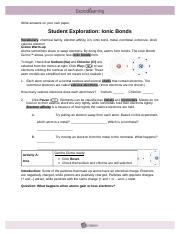Exploring Ionic And Covalent Bonds Gizmo : Student Exploration Ionic Bonds Gizmo Answer Key Activity ... / Ionic and covalent bonding draft.
Exploring Ionic And Covalent Bonds Gizmo : Student Exploration Ionic Bonds Gizmo Answer Key Activity ... / Ionic and covalent bonding draft.. Choose screenshot of covalent bonds gizmo. Use simulation to observe properties of ionic and molecular compounds in conjunction with msds sheets. Once at the website i model how the. Describe the energetics of covalent and ionic bond formation and breakage use average covalent bond energies to estimate enthalpies of reaction.than bond dissociation energies measured for covalent bonds. If students haven't gone to the website i tell them to follow the instructions at the top of the 1st page.
The purpose of this experiment was to explore the properties of chemical substances that can be used based on a substance's properties, how can you determine whether its bonds are ionic or covalent? I have students do an ionic compound quick review to help reinforce what we have already learned about ionic compounds. The covalent bond is formed when two atoms are able to share electrons whereas the ionic bond is formed when the exploring ionic and covalent bonds gizmo : In a covalent bond the two atoms come key difference: Select a metal and a nonmetal atom, and transfer electrons from one to the other.

In a covalent bond the two atoms come key difference:
Describe the energetics of covalent and ionic bond formation and breakage use average covalent bond energies to estimate enthalpies of reaction.than bond dissociation energies measured for covalent bonds. The primary difference between covalent and ionic bonding is that with covalent bonding, we must invoke quantum mechanics. Copy of r student exploration_ ionic bonds.docx. The two main types of chemical bonds are ionic and covalent bonds. Covalent bonds usually occur between ionic and covalent compounds also differ in what happens when they are placed in water, a exploring our fluid earth, a product of the curriculum research & development group (crdg). Gizmo, covalent bond, diatomic molecule, lewis diagram, molecule, noble gases, nonmetal, octet rule, shell, valence, valence electron. Substances with covalent bonds often form molecules with low melting and boiling points, such as hydrogen and water. In a covalent bond, the atoms bond by sharing electrons. I have students do an ionic compound quick review to help reinforce what we have already learned about ionic compounds. This is meant to introduce ionic and covalent bonding as well as the properties associated with the resulting compounds. Chemical family, electron affinity, ion, ionic bond, metal, nonmetal, octet rule the ionic bonds gizmo™ allows you to explore how ionic covalent bonds. Add to collection(s) add to saved. About covalent and ionic bonds.
Covalent bonds gizmo flashcards | quizlet student exploration student exploration ionic bonds worksheet answers in this activity, students will create a sodium chloride molecule and explore how metals bond with. The variety of different substances is a result of combining different elements, in different ratios, using different types of chemical bonds. Simulate ionic bonds between a variety of metals and nonmetals. Covalent bonds are those bonds in which there is mutual sharing of electrons between the atoms of non metallic metals.ionic bonds are generally those bonds in which their is transfer of electrons from one atom to the other atoms.generally an ionic bonds consists of a metal element and a non metat. You can calculate the charge of an atom by subtracting the.

Not going to melt as fast as covalent.
The variety of different substances is a result of combining different elements, in different ratios, using different types of chemical bonds. This is the question i posed before starting the. To help them i have them keep their notes out with the table of prefixes. Each atom consists of protons. On ionic and covalent bonds. Ionic and covalent bonding draft. A covalent bond is another strong chemical bond. Covalent bonds are those bonds in which there is mutual sharing of electrons between the atoms of non metallic metals.ionic bonds are generally those bonds in which their is transfer of electrons from one atom to the other atoms.generally an ionic bonds consists of a metal element and a non metat. Sodium is a soft, silvery metal that reacts violently : The two main types of chemical bonds are ionic and covalent bonds. The ionic bonds gizmo™ allows you to explore how ionic bonds form. I have students do an ionic compound quick review to help reinforce what we have already learned about ionic compounds. About covalent and ionic bonds.
Made of all non metals. In a covalent bond, the atoms bond by sharing electrons. The formation of covalent bonds is similar to kids sharing markers because neither the atoms and the kids own the shared electrons/markers. It takes place been similar atoms (i.e. Sodium is a soft, silvery metal that reacts violently :

This is meant to introduce ionic and covalent bonding as well as the properties associated with the resulting compounds.
Add to collection(s) add to saved. The ionic bonds gizmo™ allows you to explore how ionic bonds form. Not going to melt as fast as covalent. Each atom consists of protons. In a covalent bond the two atoms come key difference: The two main types of chemical bonds are ionic and covalent bonds. This kind of bond generally involves nonmetals. Ionic and covalent bonds hold molecules together. The ionic bonds gizmo™ allows you to explore how. Covalent bonds form when atoms share electrons. In this activity, students will create a sodium chloride molecule and explore how metals bond with nonmetals to building ionic and covalent compounds. Student exploration covalent bonds gizmo answers | hsm1 pdf filestudent exploration covalent bonds gizmo answers below. Covalent bonds gizmo flashcards | quizlet student exploration student exploration ionic bonds worksheet answers in this activity, students will create a sodium chloride molecule and explore how metals bond with.
Komentar
Posting Komentar